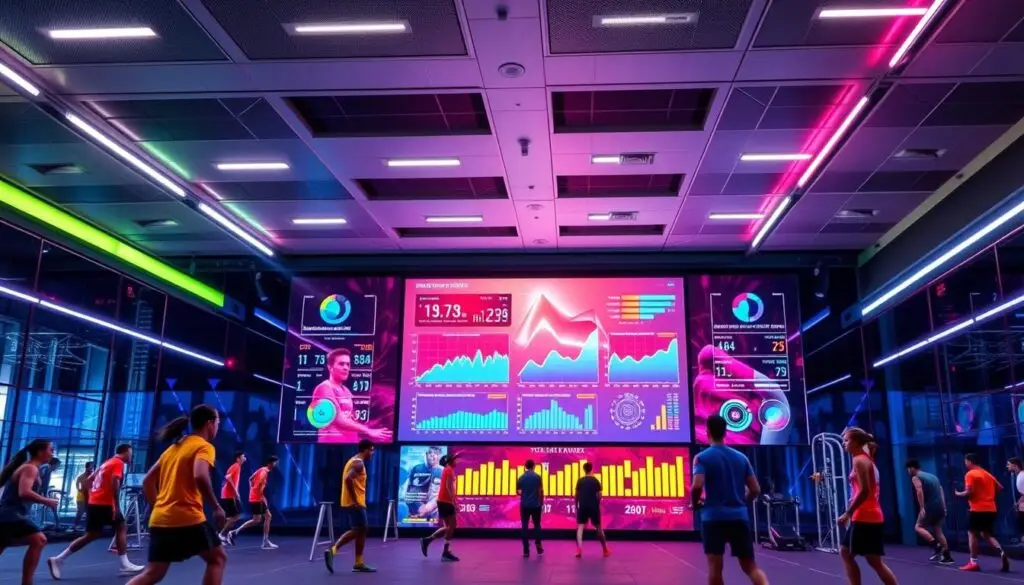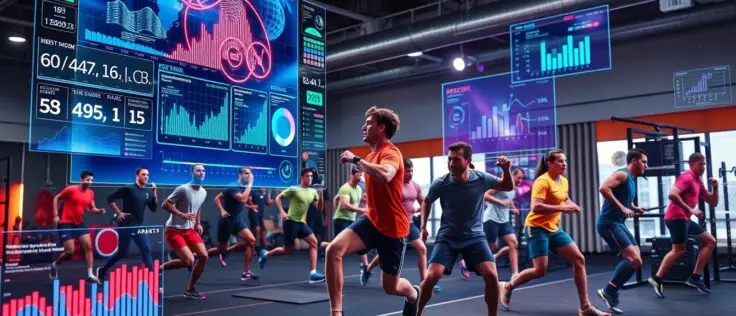In the competitive world of sports, combining Artificial Intelligence (AI) with Data Analytics is essential. The sports analytics market is booming, expected to grow from $1.9 billion in 2019 to a huge $5.2 billion by 20241. This big change is making Training Optimization and Data-Driven Decisions key to winning.
AI and machine learning are at the center of this change, improving the athlete’s experience. Wearables and IoT devices collect lots of data, helping to create specific training plans. This helps avoid injuries and boosts athlete performance1. AI’s importance is expected to grow, reaching a value of 19.2 billion dollars by 20302.
As we move towards a more data-focused sports world, the big question is — How will your team use AI to not just compete, but dominate? Discover more through Scott Dylan’s insights on the future of sports strategy and the impact of analytics and AI globally3.
Revolutionising Coaching with AI in Sports Analytics
Using AI in sports coaching is changing how we develop players and make decisions. Coaches now use high-tech tools to sharpen their game plans. They can adjust their strategies with amazing accuracy thanks to AI.
Predicting Outcomes with Precision
AI examines huge data sets to predict how players and teams will perform. It looks at how players have done before, who they’re up against, and even the weather4. Coaches use these insights to make smart choices, boosting both players and the team’s success.
Advancing Scouting with Machine Learning
Machine learning is changing how we scout for talent in sports. AI checks how players perform to spot future stars. This method helps clubs find and invest in promising talents early5. It gives teams an advantage by finding great players before everyone else does.
Optimising Training Regimens with AI Tools
AI’s role in sports is transforming how teams prepare and compete. It’s making sports analytics crucial. As AI evolves, it will continue to change sports coaching and how athletes perform.
The Impact of Data Analytics on Team Management
In the fast-paced world of sports, using sports data in team management is key. It helps create powerful strategies and make smart choices. Thanks to new tech, sports groups are becoming better and more agile in their planning and actions.
Analyzing sports performance data is now essential, not just a passing trend6. It’s predicted that sports marketing analytics will grow by 27.3% each year from 2021 to 2030. This shows how much teams rely on data for strategic planning. Using analytics helps develop detailed strategies that are flexible and forward-thinking.
Data is crucial for improving how teams find players, boost performance, and connect with fans. Teams like Brighton & Hove Albion have seen big wins, like making a record £122.8 million profit in 2023, by focusing on smart data use in player management7. Brentford FC’s rise to the Premier League also shows how data-driven decisions can challenge old methods and lead to success, even on tight budgets7.
Moreover, sports tech is making a huge economic mark, expected to hit $79 billion by 20317. Effective team management through data analysis plays a big part in this growth. It leads to victories in sports and boosts the economy too.
Data analytics does more than just improve game plans and player choices. It also changes how teams handle merchandise and make fans happy. For example, Rezzil’s collaboration with the Premier League aims to offer fans exciting new experiences7. This shows a move towards more engaging and comprehensive strategies for fans.
By focusing on data analytics, teams can monitor and uplift athlete performance and manage the business side of sports. This all-around perspective helps maintain growth and keep up in the competitive sports world. As the sector evolves, relying on sports data and strategic development will play a bigger role in defining sports’ future.
Improving Player Performance with Predictive Analysis
Predictive analysis in sports is changing the game for athletes. It helps them get better through specific, data-driven plans. Coaches now have the tools to check an athlete’s health and fitness like never before. This is great for stopping injuries and making training plans that fit each athlete.
Monitoring Athlete Health and Fitness
Reducing Injury Risks through Data Insights
Tailoring Training to Individual Needs
AI’s predictive powers are changing training and health management in sports. They’re also making sports analytics more useful. This helps us understand athlete performance and well-being in new ways.
Exploring the Role of AI Tools in Injury Prevention
AI tools are changing how we prevent injuries in sports. They combine the science of movement, instant data analysis, and detailed injury risk checks. This mix helps pros predict the tough spots athletes face in games.
Analysing Biomechanical Data
AI’s role in analysing movement is a game-changer. It spots tiny details in how athletes move that people often miss. By crunching numbers from training and matches, AI finds early signs of injury risks. This deep dive into data shapes strategies to keep athletes safe11.
Wearable Tech and Real-Time Monitoring
Wearable gadgets let coaches and medics watch over athletes all the time. Things like GPS and heart rate monitors feed live info to AI. The AI then checks for signs of tiredness and other injury risks. Quick decisions made from this info help prevent pushing athletes too hard12.
Anticipating Stresses on Athletes' Bodies
AI can predict the strains athletes may face in competitions. It uses past and current data to spot likely injury spots and their effects. Teams can tailor training to lessen damage, helping athletes last longer and stay at the top of their game13.

Game Strategy Development with Machine Learning
The way machine learning is changing competitive sports is exciting. By using old data and sophisticated algorithms, teams can now create game plans that adapt in real-time. This prepares them for tactical wins14. Techniques like statistical learning and game theory are key players. For example, statistical learning helps make models that predict how well a player will do14. On the other hand, game theory helps make smarter moves in tense moments, like penalty kicks14.
Machine learning shines by quickly handling massive data. This greatly helps with making quick decisions during games15. Also, using computer vision technology changes how strategies are made by giving clear data on how players move14. This lets coaches make choices that are both planned and reactive.
Machine learning’s growth changes how sports strategies are made. It supports better training and development through data. Moving from old strategy ways to data-focused methods highlights the need for speedy analytics15. By mixing AI with expert opinions, teams get better at handling sports’ complexities. This boosts player skills and keeps fans interested1615.
As concerns like data privacy and AI ethics grow15, it’s vital for sports groups to use machine learning the right way. By focusing on strategic analytics and tailored plans, they uphold sportsmanship while pushing towards future innovations.
Optimising Player Training with Data-Driven Decisions
Sports are evolving fast with data-driven strategies to improve player training. Advanced analytics and machine learning make training methods personalised. This helps each athlete reach their best performance.
Personalised Workouts and Tech-Enabled Drills
Personalised workouts are changing how athletes train. Data from wearables and sensors shapes training to their needs and weak spots. It boosts performance and cuts injury risks, as the Australian Institute of Sport shows with lower athlete injury rates17.
Tracking Progress with Advanced Analytics
Adapting to Players’ Evolving Performance Metrics
Training must evolve with athletes. Data analytics is crucial for this change. By analysing performance, algorithms design the best training for an athlete’s needs. This is used in team and individual sports, like Formula 1, where RaceWatch boosts race plans with machine learning19.
For more on AI in other areas like marketing, check out a detailed look at AI in email. It shows how predictive analytics and real-time insights can improve engagement.
These new methods enhance performance and prepare athletes to stay at their best. They adapt better to their sport’s challenges.
How Sports Technology Enhances Fan Engagement
Sports Technology has completely changed how fans experience games, making it more immersive. AI helps personalise this experience. It makes games more exciting and interactive. ESPN, for example, uses AI to provide deep analyses of games as they happen20.
Interactive elements, like AI-augmented reality in the NFL and player tracking in the NBA, bring games to life. They offer insights and statistics in real-time20. This tech is not just for pro leagues. It’s also enhancing how fans enjoy sports on social media and apps.
OTT platforms like ESPN+ and DAZN show how tech keeps fans engaged. They offer content matched to what fans enjoy20. This way of experiencing sports is new and exciting. It shows how tech can make fan engagement better.
But, using this tech raises questions about privacy and ethics20. As the industry grows, it must think about how it uses fan data. Keeping data use transparent is key.
The use of AI and Sports Technology makes being a fan more dynamic and inclusive. It’s important for the future of sports. Innovation will keep connecting sports with fans around the world.
Understanding the Global Sports Analytics Market Growth
The Sports Analytics Market is growing fast. This is because new technologies make it useful not just for big sport teams, but also for smaller groups starting out. Now valued at USD 3.52 billion in 2023, it’s expected to grow rapidly, reaching a higher value by 203022. This huge growth shows how important it is to the sports world.
Sports analytics play a big role in how businesses make money. They allow companies to make smart choices that improve how they compete and work. For instance, in shops, using AI to set prices helps earn more money and keeps customers happy. This shows how using data changes the way businesses operate. For more info about AI and pricing, have a look at this in-depth study on AI in retail.
Investment Trends in Sports Tech
Money keeps flowing into sports tech, with no sign of stopping. Funding is especially going into analysing games and smart sports gear. These investments are crucial. They bring new ideas to sports teams, helping the world of sports analytics to grow and change.
The Forecast of AI's Economic Impact on Sports
AI’s big role in sports is not just about new tech. It’s also about its huge effect on the economy of sports. By 2030, it’s the media part of sports that will grow the fastest. This means that sports media will need better sports analytics tools more than ever22.
Emergence of Small Team Adoption of Data Analytics
Before, only the big teams could use data analytics. Now, that’s changing. Small Team Innovation is spreading. Even small sports clubs are now using these tools. They use detailed data to make their strategies better and improve how players perform22.
'AI in Sports Analytics': Shaping the Future of Professional Sports
In the fast-paced world of professional sports, AI and sports analytics are becoming key for change. By 2023, the sports market could reach $512.14 billion. This growth is fueled by AI, giving teams and athletes a vital edge23. AI helps predict player performance and injuries. It also creates tailored training plans to boost each athlete’s abilities. This makes AI a powerful force in sports24. Looking ahead, technology and athleticism will join to enhance, secure, and fair competition.
The AI part of sports is expected to grow to $19.2 billion by 2030. This shows how much people trust and invest in this tech2423. In the USA, the NFL uses AI to break down game films for better player performance. Meanwhile, MLB relies on it for player decision-making24. This shift means even smaller teams can compete against bigger ones. They get similar data and tools, making the competition fairer24.
AI is changing training and strategy, and how fans enjoy games. With Arsenal’s “Robot Pires” chatbot, fans get match and player info in real-time23. Statcast in baseball, collecting 3,000 pieces of data per second, has changed how we see performance. It combines detailed data analysis with the excitement of sports23. As we move towards 2030, it’s clear. AI is transforming the sports industry’s core. It ensures that every action is as data-driven as it is determined2423.
FAQ
How is AI enhancing sports performance and training optimization?
AI is changing sports by looking closely at big data to find new insights. This helps improve how athletes train. Trainers use these insights to better athlete and team performance. Tools like simulation models and real-time data analysis guide trainers in making smart, data-backed choices.
What are the benefits of using predictive analysis in coaching?
Predictive analysis helps coaches by forecasting players’ risks and performances. It enables customised training and strategies. This ensures athletes perform their best, reducing injury risks.
How does machine learning advance talent scouting and player performance?
Machine learning analyses lots of player data to spot patterns and predict future performance. This helps in choosing players wisely, focusing on their potential. It moves beyond judging by past actions alone.
In what ways does AI impact team management and strategy development?
AI provides detailed data analysis for team management. This information helps in crafting better strategies. Managers use these insights to play on their strengths and pin down opponents’ weaknesses, leading to smarter decisions.
What role does predictive analysis play in improving athlete health monitoring?
Predictive analysis is key in keeping athletes healthy. It uses real-time data to flag potential injuries or fatigue early. Early action can then be taken to stop health issues before they worsen, helping athletes last longer in their careers.
How can data insights reduce injury risks for athletes?
Wearable technology provides data that highlights injury risks. Teams then personalise training to prevent these risks. This tailored approach cuts down the chances of injuries.
What are the advantages of tailoring training to an athlete’s individual needs?
Custom training considers each athlete’s strengths and limits. It maximises their performance and helps the team succeed. It also guards against overtraining and injuries.
How do AI tools contribute to injury prevention?
AI analyses biomechanical data and monitors athletes in real time. It can forecast injury risks, allowing for pre-emptive actions. Adjusting training or suggesting rest can prevent injuries.
Can machine learning improve the development of game strategies?
Machine learning enhances strategy by studying past games and stats. It helps coaches devise plans that outsmart opponents and minimise risks.
What is the significance of personalised workouts and tech-enabled drills?
Custom workouts and tech-based drills focus on needed improvements. Technology tracks performance, making practice more effective and getting athletes ready for events.
How does advanced analytics help in tracking progress and adapting training?
Advanced analytics show how an athlete is improving over time. Coaches see what works best and can adjust training for better results and peak performance.
In what way does sports technology enhance fan engagement?
Sports tech boosts fan involvement with exciting, new ways to connect. Things like virtual reality and real-time stats make watching sports more engaging. This tech creates a closer link between fans and the sports they love.
What are the current investment trends in sports technology?
Money flowing into sports tech is on the rise. Interest is growing in areas like predictive analytics and fan experiences. Companies are investing more in tech that improves how fans and athletes experience sports.
How will AI’s economic impact on sports evolve in the future?
AI will play a bigger role in sports economics moving forward. It will make operations smoother, create new ways to make money, and give teams of any size advanced tools. This shifts how money is made and spent in sports.
How important is small team adoption of data analytics?
For smaller teams, using data analytics is vital. It levels the playing field, letting them make smarter choices about everything from training to scouting. This boosts competition quality at all sport levels.
What is the future of professional sports with the integration of AI in sports analytics?
The future of sports with AI is smarter and more tailored. Insights from AI will enhance performances, fan enjoyment, and player health. This massive change will reshape the sports world.
Source Links
- AI in Sports Analytics: Enhancing Team Performance – Ever Efficient AI – https://everefficient.ai/posts/ai-in-sports-analytics-enhancing-team-performance/
- Importance of AI and data analytics in sports – https://www.softwebsolutions.com/resources/ai-data-analytics-use-cases-in-sports.html
- Beyond the game: The impact of data analytics on sports performance – Eaton Business School – https://ebsedu.org/blog/impact-of-data-analytics-on-sports-performance
- The Game Changer: How AI is Revolutionizing Sports Analytics – https://www.linkedin.com/pulse/game-changer-how-ai-revolutionizing-sports-analytics-rama-chintakunta-liakc
- Sports Analytics AI for Enhanced Performance and Strategy | Spark Emerging Technologies – https://sparkemtech.co.uk/blog/sports-analytics-ai-revolutionising-performance-and-strategy
- The Impact of Data Analytics in Sports Industry – https://www.appventurez.com/blog/data-analytics-in-sports
- Data & Analytics in Sport: The AI Game Changer – https://wypartners.com/data-analytics-in-sport-the-ai-game-changer/
- Improve your players’ performance with AI – Gemmo.AI – https://gemmo.ai/improve-your-sports-performance-with-ai/
- AI & Sports Analytics: Revolutionizing Performance Insights – https://newo.ai/insights/ai-and-sports-analytics-revolutionizing-performance-insights/
- AI in Sports: A Deep Dive into Predictive Analytics Revolution – https://www.i-webservices.com/blog/ai-in-sports/
- Artificial Intelligence in Sports Industry : Exploring Impact & Innovation – https://www.itpathsolutions.com/ai-in-sports-industry/
- Artificial intelligence and Machine Learning approaches in sports: Concepts, applications, challenges, and future perspectives – https://www.ncbi.nlm.nih.gov/pmc/articles/PMC11215955/
- AI in Sports: Applications and Use Cases – https://appinventiv.com/blog/ai-in-sports/
- AI & Sports Analytics- Game Strategy, Player Development and Scouting – https://www.linkedin.com/pulse/ai-sports-analytics-game-strategy-player-development-dr-jagrrit-k-d5ooc
- Future Trends in Sports Analytics: Lessons from the Field – https://www.missioncloud.com/blog/future-trends-in-sports-analytics-lessons-from-the-field
- Getting Started with Artificial Intelligence in Sports Science – https://www.globalperformanceinsights.com/post/getting-started-with-artificial-intelligence-in-sports-science
- AI and Data Analytics in Sports – https://www.linkedin.com/pulse/ai-data-analytics-sports-lanetteamsurat-l1ggf
- AI in Sports Analytics and Performance Optimization – https://medium.com/@perfectdesigner/ai-in-sports-analytics-and-performance-optimization-b6ee43eb7fc9
- Machine Learning in Sports Analytics | Catapult – https://www.catapult.com/blog/sports-analytics-machine-learning
- Evolution of AI in sports broadcasting: Redefining the fan experience in 2024 – https://www.svgeurope.org/blog/headlines/evolution-of-ai-in-sports-broadcasting-redefining-the-fan-experience-in-2024/
- Enhancing Sports Performance and Fan Engagement with AI – https://medium.com/@emberliyy2024/enhancing-sports-performance-and-fan-engagement-with-ai-fc8a9a72c170
- Sports Analytics Market Size, Share & Growth Report, 2030 – https://www.grandviewresearch.com/industry-analysis/sports-analytics-market
- Council Post: Can AI Score Big In The Future Of Sports? Five Key Trends Shaping The Industry – https://www.forbes.com/councils/forbestechcouncil/2023/09/27/can-ai-score-big-in-the-future-of-sports-five-key-trends-shaping-the-industry/
- How AI is Transforming the Sports Industry in 2024? – https://imaginovation.net/blog/ai-in-sports-industry/






